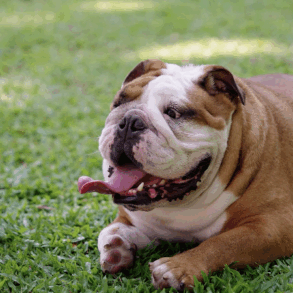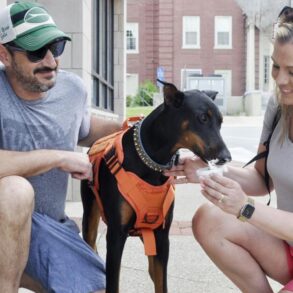
Texas summer heat is no joke—and it’s not just a threat for humans. Our animal companions can struggle with sweltering temps long before it hits triple digits.
“Any time the temperature is above 85 degrees, or if the heat index is over 100 degrees, people should use caution when walking their dogs outside,” says veterinarian Alexis Bardzinski, the medical director at local nonprofit Austin Pets Alive!
Dogs and cats have a harder time cooling down because they are covered in fur and can’t sweat like humans, so they rely on evaporative cooling, mostly through panting and licking.
According to the American Kennel Club, there are two types of sweat glands in dogs: merocrine glands and apocrine glands. Merocrine glands are found in the paws, and they function similarly to human sweat glands. When these glands activate on a hot day, you may notice damp paw prints on the ground. Apocrine glands are considered sweat glands by veterinarians, but their primary function is to release pheromones, which help dogs identify other dogs by scent.
While all pups struggle in the heat, flat-faced and long-haired breeds are much more sensitive, such as French bulldogs, German shepherds, Labradoodles, goldendoodles, huskies, pugs, and English bulldogs.
So, how do we protect our pets from the extreme heat? Here are a few tips from Bardzinski.
1 / Keep them hydrated.
Make sure your dog always has access to fresh water.
2 / Check the pavement.
Before going for a walk, place your hand on the pavement. If it’s too hot for your hand, it’s too hot for your dog’s paws. Consider walking in the early morning or late evening to avoid the hot ground.
3 / Watch their body language.
Keep an eye out for signs of overheating such as red eyes, excessive panting, and lagging during walks. If you notice these signs, give your dog a break from the heat.
4 / Limit outdoor activity.
Try to keep your dog indoors during the hottest parts of the day. If your pup is outside, provide access to shade and cool areas, such as playing in sprinklers or a kiddie pool.
5 / Never leave them inside a car.
Remember that leaving your dog inside a car can be dangerous, even for a brief period. Temperatures inside a vehicle can reach 140 degrees within minutes.
Be aware that even temps in the 80s and 90s can pose a serious risk of overheating for our pets. Following these guidelines will make a real difference as we approach the dog days of summer.
This post was originally published on this site be sure to check out more of their content.













































